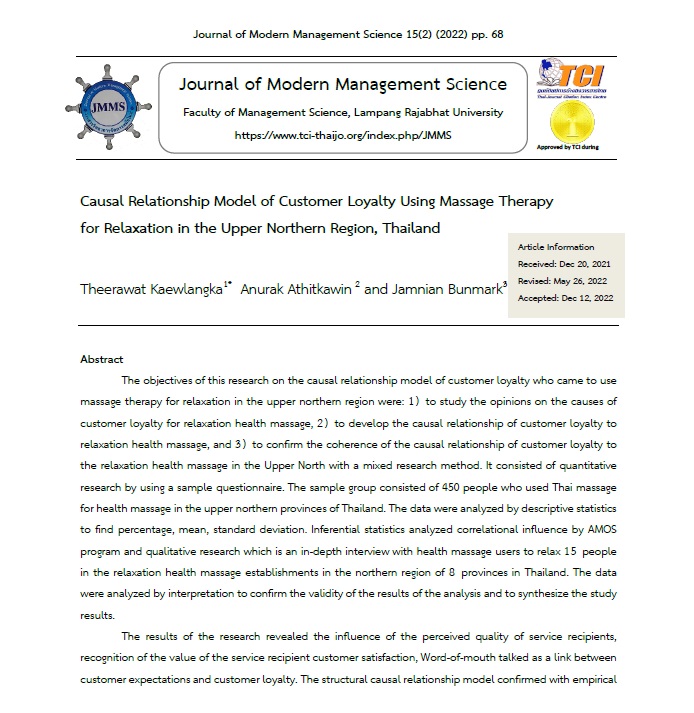Causal Relationship Model of Customer Loyalty Using Massage Therapy for Relaxation in the Upper Northern Region, Thailand
Main Article Content
Abstract
The objectives of this research on the causal relationship model of customer loyalty who came to use massage therapy for relaxation in the upper northern region were: 1) to study the opinions on the causes of customer loyalty for relaxation health massage, 2) to develop the causal relationship of customer loyalty to relaxation health massage, and 3) to confirm the coherence of the causal relationship of customer loyalty to the relaxation health massage in the Upper North with a mixed research method. It consisted of quantitative research by using a sample questionnaire. The sample group consisted of 450 people who used Thai massage for health massage in the upper northern provinces of Thailand. The data were analyzed by descriptive statistics to find percentage, mean, standard deviation. Inferential statistics analyzed correlational influence by AMOS program and qualitative research which is an in-depth interview with health massage users to relax 15 people in the relaxation health massage establishments in the northern region of 8 provinces in Thailand. The data were analyzed by interpretation to confirm the validity of the results of the analysis and to synthesize the study results.
The results of the research revealed the influence of the perceived quality of service recipients, recognition of the value of the service recipient customer satisfaction, Word-of-mouth talked as a link between customer expectations and customer loyalty. The structural causal relationship model confirmed with empirical data χ2 = 345.420, df = 1.117, χ2 / df = 345, GFI = .066, CFI = .948, RMR= .019, RMSEA = .016. The perceived quality of service recipients had no direct influence or little influence on perceived value of service recipients with a route coefficient of 0.162.
Article Details

This work is licensed under a Creative Commons Attribution-NonCommercial-NoDerivatives 4.0 International License.
The article must be considered and accepted for publication by the editorial board of the Faculty of Management Science, Lampang Rajabhat University. The articles have been reviewed by a peer (peer review) and the author must update according to the suggestion if available before publication. Articles that are not considered the editorial team will inform the results of the consideration but will not send the original to the author.
JMMS is the Faculty of Management Science journal, Lampang Rajabhat University. Jmms published both print and online editions. We allow the use of articles for academic use under the scope of copyright law.
References
Anderson, E. W., Fornell, C., & Lehman, D. R. (1994). Customer satisfaction, market share and profitability: Findings from Sweden. Journal of Marketing, 58(3): 53-67.
Anderson, E.W., & Sullivan, M.W. (1993). The Antecedents and Consequences of Customer Satisfaction for Firms. Marketing Science, 12: 125-143.
Chanthanawan, S., & Fongthanakit, R. (2019). Factors affecting decision making on using Spa services towards Consumers in Chatuchak District, Bangkok. Journal of the Association of Researchers, 24(3): 190-204.
Cronin, J. J. Jr., Brady, M. K., & Hult, G. T. M. (2000). Assessing the effects of quality, value, and customer satisfaction on consumer behavioral intentions in service environments. Journal of Retailing, 76(2) : 193–218
Hellier, P. K., Geursen, G. M., Carr, R. A., & Rickard, J. A. (2003). Customer repurchase intention: a general structural equation model. European journal of marketing, 37(11): 1762-1800
Hennig-Thurau, T., & A. Klee. (1997). The Impact of Customer Satisfaction and Relationship Quality on Customer Retention - A Critical Reassessment and Model Development. Psychology & Marketing, 14(8): 737–765.
International Health Division. (2014). Summary report on the performance of Thailand's development policy. To become an international health center (Medical Hub), Fiscal Year 2014. Bangkok: Ministry of Health
Jadesadalug, J., & Patchai, O. (2018). The Competitive advantage strategy of business Big Dog Café, Chatuchak District, Bangkok. Veridian E-Journal, Silpakorn University, 11(1): 3157-3174
Kundu, S., & Rajan, CR. S. (2017). Word of Mouth: A Literature Review. International Journal of Economics & Management Sciences, 6(6): 1-9.
Ministry of Tourism and Sports. (2019). Tourism Statistics 2018. Retrieved Sep. 28th 2019: from https://www.mots.go.th/ more_news_new.php?cid=521,
Navavongsathian, A. (2018). The Brand Exposure, Electronic-Word-of-Mouth Communications and Customer Satisfaction through social media Affecting Private Label Brand Trust. Journal of Business Administration, 7(1):23-37.
Parasuraman, A., Zeithaml, V. A., & Berry, L. L. (1985). A conceptual model of service quality and Its Implications for Future Research. Journal of Marketing, 49(4), 41-50.
Parasuraman, A., Zeithaml, V. A., & Berry, L. L. (1988). SERVQUAL: A multiple-item scale for measuring consumer perceptions of service quality. Journal of Retailing, 64(1): 12–40.
Phrommuang, C., & Sawang, S. (2018). Marketing mix factors affecting the decision-making process of consumers in choosing a Thai massage shop in Pathum Thani province. Business Research Journal and Administration, 4(2): 387-406.
Srirak, N. (2019). Perception of quality of Thai massage for health, Applied Thai Massage Clinic, Faculty of Public Health, Mahidol University. The 29th Thaksin University National Academic Conference 2019, Research and Innovation for Sustainable Development, 2015-2024.
Stevens, J. P. (1992). Applied Multivariate Statistics for the Social Sciences. NJ: Lawrence Erlbaum Associates. Hillsdale.
Tabachnick, B. G., & Fidell, L. S. (2007). Using Multivariate Statistics (5th ed.). New York: Allyn and Bacon.
Thammasanae, S. (2017). Health Service Industry potentiality: Case Study of Thai Massage in Phitsanulok. The 7th National Research Conference, Suan Sunandha Rajabhat University, 1431-1445
Thongthab, S. (2019). Elevate Thai spa to international level Take a share of the world market 27 Million Baht Retrieved Sep. 27th 2019 from https://www.thebangkokinsight.com/news/business/economics/125178
Zeithaml, V. A. (1988). Consumer perceptions of price, quality, and value: A means-end model and synthesis of evidence. Journal of Marketing, 52(3), 2-22.
Zeithaml, V., Berry, L., & Parasuraman, A. (1996) The Behavioral Consequences of Service Quality. Journal of Marketing. 60(2), 31-46.

